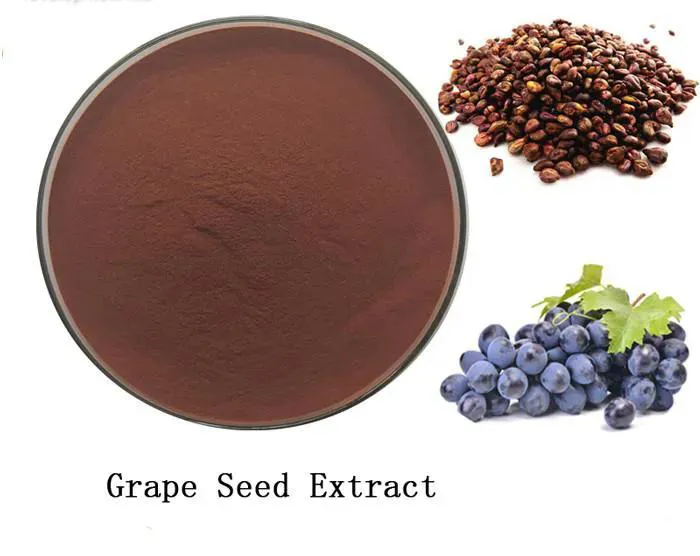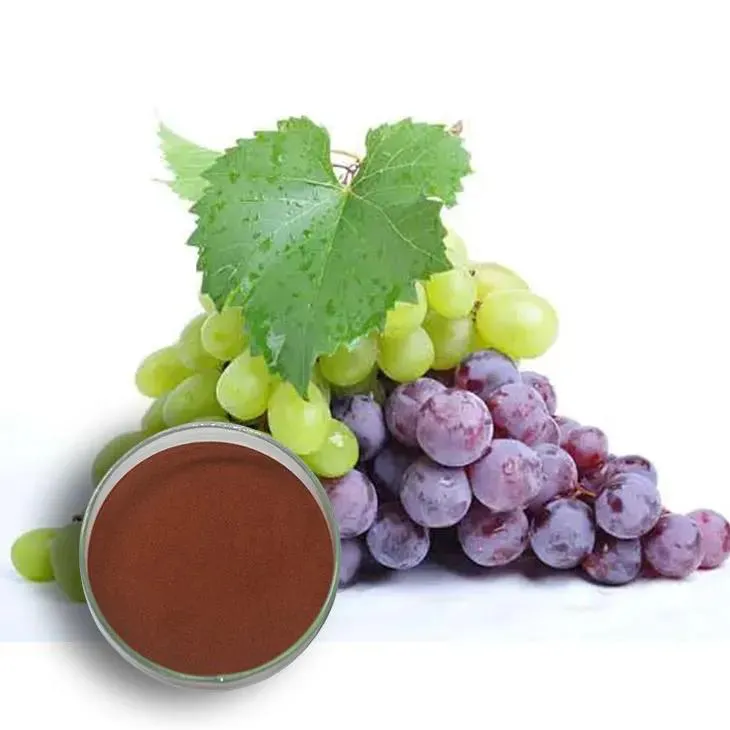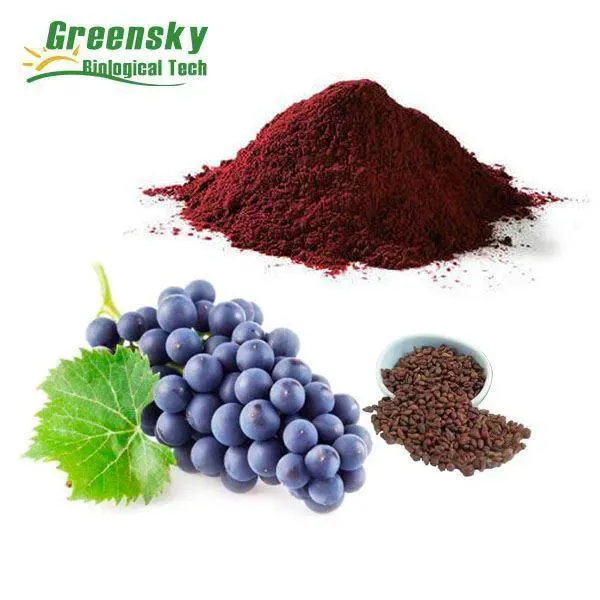- 0086-571-85302990
- sales@greenskybio.com
From Seed to Skin: A Comprehensive Guide to Grapefruit and Grape Seed Extracts for Melasma
2024-07-26

1. Introduction to Melasma
Melasma is a common skin condition that primarily affects the face. It is characterized by the appearance of brown or gray - brown patches on the skin. These patches are often symmetrical and can be found on the cheeks, forehead, nose, and upper lip. Melasma is more prevalent in women, especially those with darker skin tones, and is often associated with hormonal changes, such as pregnancy or the use of hormonal contraceptives. Sun exposure is also a significant trigger for melasma, as ultraviolet (UV) rays can stimulate the production of melanin in the skin, exacerbating the appearance of the patches.

2. Grapefruit and Grape Seed Extracts: An Overview
2.1 Grapefruit Extract
Grapefruit extract is derived from the fruit of the grapefruit tree (Citrus paradisi). It contains a variety of bioactive compounds, including vitamins (such as vitamin C), flavonoids, and phenolic acids. These components contribute to its antioxidant, anti - inflammatory, and skin - brightening properties. The vitamin C in grapefruit extract is a powerful antioxidant that helps to neutralize free radicals in the skin, which can cause damage to skin cells and contribute to the development of melasma.2.2 Grape Seed Extract
Grape Seed Extract is obtained from the seeds of grapes (Vitis vinifera). It is rich in proanthocyanidins, which are a type of flavonoid. Proanthocyanidins have strong antioxidant capabilities, far exceeding those of vitamin C and vitamin E. They can protect the skin from oxidative stress, which is a key factor in the development of melasma. Additionally, grape seed extract has anti - inflammatory properties, which can help to soothe the skin and reduce redness associated with melasma.
3. The Composition of Grapefruit and Grape Seed Extracts
3.1 Chemical Components of Grapefruit Extract
- Flavonoids: Grapefruit contains various flavonoids, such as naringin, Hesperidin, and rutin. These flavonoids play important roles in antioxidant and anti - inflammatory activities. Naringin, for example, has been shown to have antioxidant effects and can also inhibit the activity of tyrosinase, an enzyme involved in melanin production. - Vitamin C: As mentioned earlier, vitamin C is a crucial component of grapefruit extract. It is essential for collagen synthesis in the skin, which helps to maintain the skin's elasticity and firmness. Moreover, it can reduce the formation of melanin by interfering with the melanin - synthesizing pathway. - Phenolic Acids: Phenolic acids in grapefruit, such as caffeic acid and ferulic acid, also contribute to its antioxidant properties. They can scavenge free radicals and protect the skin from environmental damage.3.2 Chemical Components of Grape Seed Extract
- Proanthocyanidins: These are the main bioactive compounds in grape seed extract. They are large molecules composed of multiple flavan - 3 - ol units. Proanthocyanidins can form a protective layer on the skin, preventing the penetration of harmful substances and reducing the damage caused by UV radiation. - Other Flavonoids: In addition to proanthocyanidins, grape seed extract also contains other flavonoids, such as Quercetin and catechin. These flavonoids have antioxidant and anti - inflammatory properties, which can further enhance the beneficial effects of the extract on the skin.
4. Antioxidant Benefits for Melasma
4.1 Free Radical Scavenging
Both grapefruit and grape seed extracts are rich in antioxidants, which are crucial for combating melasma. Free radicals are highly reactive molecules that can damage skin cells and disrupt the normal function of the skin. UV radiation, pollution, and stress are common sources of free radicals in the skin. The antioxidants in grapefruit and grape seed extracts can scavenge these free radicals, preventing them from causing further damage to the skin. For example, the vitamin C in grapefruit extract and the proanthocyanidins in grape seed extract can donate electrons to free radicals, neutralizing them and reducing their reactivity.4.2 Protection Against Oxidative Stress
Oxidative stress occurs when there is an imbalance between the production of free radicals and the body's antioxidant defenses. In the context of melasma, oxidative stress can stimulate the production of melanin in the skin, leading to the darkening of the patches. Grapefruit and grape seed extracts can help to restore the balance by providing additional antioxidant protection. They can enhance the skin's antioxidant defense system, making it more resistant to oxidative stress. This, in turn, can help to prevent the worsening of melasma and may even lead to a reduction in the appearance of the patches over time.
5. Skin - Enhancing Benefits for Melasma
5.1 Skin Brightening
The components in grapefruit and grape seed extracts can contribute to skin brightening, which is beneficial for melasma sufferers. The inhibition of tyrosinase activity by compounds such as naringin in grapefruit extract can reduce melanin production. Grape seed extract, with its antioxidant and anti - inflammatory properties, can also help to improve the overall complexion of the skin. By reducing inflammation and protecting the skin from damage, it can make the skin look healthier and more radiant, thereby reducing the contrast between the melasma patches and the surrounding skin.5.2 Anti - Inflammatory Effects
Inflammation is often associated with melasma, and reducing inflammation can be an important step in managing the condition. Both grapefruit and grape seed extracts have anti - inflammatory properties. The flavonoids and phenolic acids in grapefruit extract, as well as the proanthocyanidins in grape seed extract, can inhibit the production of inflammatory mediators in the skin. This can help to soothe the skin, reduce redness, and improve the overall appearance of melasma - affected areas.5.3 Collagen Promotion
Vitamin C in grapefruit extract is essential for collagen synthesis. Collagen is a key structural protein in the skin that provides support and elasticity. As melasma can sometimes be associated with a weakening of the skin's structure, promoting collagen synthesis can help to improve the skin's condition. By increasing collagen production, grapefruit extract can help to make the skin more firm and resilient, which may also contribute to a reduction in the appearance of melasma patches.6. Incorporating Grapefruit and Grape Seed Extracts into Your Skincare Routine
6.1 Topical Application
- Choosing the Right Products: Look for skincare products that contain grapefruit or grape seed extracts. These can include creams, serums, and masks. When choosing a product, make sure to check the ingredient list and ensure that the extract is listed high up, indicating a higher concentration. - Patch Testing: Before applying a new product containing these extracts to your entire face, it is advisable to perform a patch test. Apply a small amount of the product to a small area of skin, such as the inside of your forearm, and wait for 24 - 48 hours to see if any adverse reactions occur, such as redness, itching, or swelling. - Application Frequency: Start with a low - frequency application, such as every other day, and gradually increase the frequency if your skin tolerates it well. Most products can be applied once or twice a day, depending on the instructions.6.2 Dietary Incorporation
- Grapefruit Consumption: Including grapefruit in your diet can provide some of the benefits of its extract. You can eat fresh grapefruit or drink grapefruit juice. However, be cautious if you are taking certain medications, as grapefruit can interact with some drugs. - Grape Seed Supplements: Grape seed supplements are available in the form of capsules. If you choose to take grape seed supplements, make sure to follow the recommended dosage instructions. It is also advisable to consult a healthcare provider before starting any new supplement, especially if you have any underlying health conditions or are taking other medications.7. Precautions and Considerations
7.1 Allergic Reactions
Some individuals may be allergic to grapefruit or grape seed extracts. Allergic reactions can range from mild skin irritation to more severe symptoms such as difficulty breathing or swelling of the face, lips, or tongue. If you experience any signs of an allergic reaction after using products containing these extracts or consuming grapefruit, discontinue use immediately and seek medical attention.7.2 Interaction with Medications
Grapefruit can interact with a number of medications, including some blood pressure medications, statins, and anti - arrhythmic drugs. The compounds in grapefruit can affect the way these drugs are metabolized in the body, potentially leading to increased levels of the drugs in the bloodstream and an increased risk of side effects. If you are taking any medications, it is important to consult your doctor or pharmacist before consuming grapefruit or using products containing grapefruit extract.7.3 Quality and Purity of Extracts
When choosing skincare products or supplements containing grapefruit or grape seed extracts, it is important to ensure their quality and purity. Look for products from reputable manufacturers that adhere to good manufacturing practices. Poor - quality extracts may not provide the expected benefits and may even contain contaminants that could be harmful to the skin or health.8. Conclusion
Grapefruit and grape seed extracts offer a promising natural approach to managing melasma. Their antioxidant, skin - enhancing, and anti - inflammatory properties make them valuable additions to a skincare routine. However, it is important to use these extracts with caution, taking into account potential allergic reactions, interactions with medications, and the quality of the products. By understanding the benefits and limitations of grapefruit and grape seed extracts, individuals with melasma can make informed decisions about incorporating them into their skincare and dietary regimens for the management of this common skin condition.
FAQ:
What is melasma?
Melasma is a common skin condition characterized by brown or gray - brown patches, usually on the face. It is often associated with hormonal changes, sun exposure, and genetic factors.
How do grapefruit and grape seed extracts help with melasma?
Grapefruit and its seed extracts contain various beneficial compounds. Their antioxidant properties help combat free radicals that can damage the skin and contribute to melasma. Additionally, they may have skin - enhancing effects that can lighten the dark patches associated with melasma.
What are the main components in grapefruit and grape seed extracts that are beneficial for melasma?
Grapefruit contains vitamins such as vitamin C, which is known for its antioxidant and skin - brightening properties. Grape seed extracts are rich in polyphenols, which also have antioxidant and anti - inflammatory effects that can be beneficial in treating melasma.
Can grapefruit and grape seed extracts completely cure melasma?
While grapefruit and grape seed extracts can be helpful in managing melasma, they may not completely cure it. Melasma is a complex condition, and a comprehensive approach including sun protection, proper skincare, and in some cases, medical treatment may be required.
How can one incorporate grapefruit and grape seed extracts into their skincare routine?
One can use skincare products that contain grapefruit or grape seed extracts, such as creams, serums, or masks. Some people may also choose to make their own natural skincare remedies using grapefruit juice or crushed grape seeds, but it's important to be cautious as these natural substances can also cause skin irritation in some cases.
Related literature
- The Role of Antioxidants in Skin Health and Melasma Treatment"
- "Grapefruit Extracts: A Promising Ingredient for Skin Disorders"
- "Beneficial Effects of Grape Seed Extract on Skin Pigmentation"
- ▶ Hesperidin
- ▶ Citrus Bioflavonoids
- ▶ Plant Extract
- ▶ lycopene
- ▶ Diosmin
- ▶ Grape seed extract
- ▶ Sea buckthorn Juice Powder
- ▶ Fruit Juice Powder
- ▶ Hops Extract
- ▶ Artichoke Extract
- ▶ Mushroom extract
- ▶ Astaxanthin
- ▶ Green Tea Extract
- ▶ Curcumin
- ▶ Horse Chestnut Extract
- ▶ Other Product
- ▶ Boswellia Serrata Extract
- ▶ Resveratrol
- ▶ Marigold Extract
- ▶ Grape Leaf Extract
- ▶ New Product
- ▶ Aminolevulinic acid
- ▶ Cranberry Extract
- ▶ Red Yeast Rice
- ▶ Red Wine Extract
-
Kidney Bean Extract
2024-07-26
-
Camu Camu Extract
2024-07-26
-
Kelp Extract Powder
2024-07-26
-
Hawthorn Extract
2024-07-26
-
Mulberry Extract
2024-07-26
-
Yellow Pine Extract
2024-07-26
-
Resveratrol extract
2024-07-26
-
Sophora Flavescens Root Extract
2024-07-26
-
Peppermint Extract Powder
2024-07-26
-
Hawthorn powder
2024-07-26





















